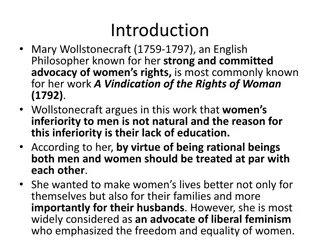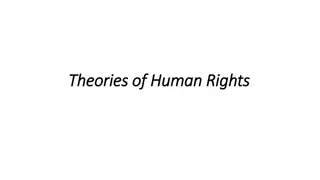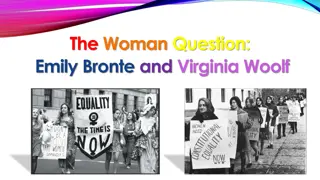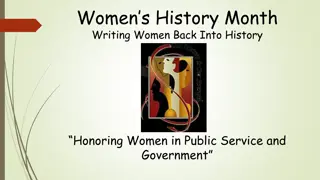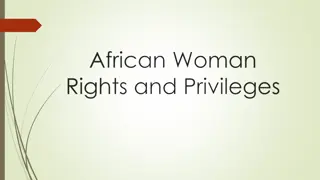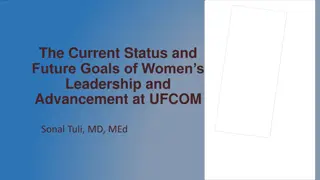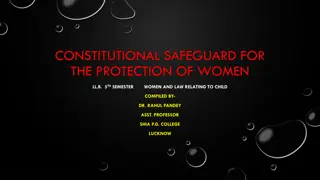Evolution of Women's Rights Through History
Women's rights have evolved significantly over time, with milestones such as the right to vote in 1918 for women over 30 with property and later in 1928 for all women over 21, suffragette movements, Margaret Thatcher becoming the UK's first female Prime Minister in 1979, Diane Abbott becoming the first woman of color elected to Parliament in 1987, and the Dagenham strike leading to the Equal Pay Act in 1970.
Download Presentation

Please find below an Image/Link to download the presentation.
The content on the website is provided AS IS for your information and personal use only. It may not be sold, licensed, or shared on other websites without obtaining consent from the author.If you encounter any issues during the download, it is possible that the publisher has removed the file from their server.
You are allowed to download the files provided on this website for personal or commercial use, subject to the condition that they are used lawfully. All files are the property of their respective owners.
The content on the website is provided AS IS for your information and personal use only. It may not be sold, licensed, or shared on other websites without obtaining consent from the author.
E N D
Presentation Transcript
Women over thirty with 5 of property ( 275 in today s money) are given the right to vote. 1918
All women over the age of 21 are given the right the vote. 1928
The Suffragettes In 1903, Emmeline Pankhurst formed the Women s Social and Political Union, known now as the suffragettes. The suffragettes motto was deeds, not words . They were determined to get women the right to vote, and they were prepared to use any means necessary to do so. They smashed windows on London s Oxford Street; set fire to churches; chained themselves to the gates of Buckingham Palace; went on hunger strike in prison; and sailed the Thames in order to shout abuse through loud hailers at Parliament whilst MPs met.
The Suffragettes In 1918, as a result of the suffragettes campaigns, the Representation of the People Act was passed. This law gave women over 30 years old with 5 of property (about 275 in today s money) the right to vote. This law led to 8.4million newly enfranchised women. A separate Act in 1918 gave women the right to run for parliament. In 1928, the Equal Franchise Act gave all women over the age of 21 the right to vote, regardless of property ownership. Today, all women over the age of 18 can vote.
Margaret Thatcher becomes the UK s first female Prime Minister 1979
Diane Abbot becomes the first woman of colour elected to Parliament. 1987
Women sewing machinists at a Ford Motors factory in Dagenham strike for equal pay between men and women. Two years later, the Equal Pay Act is passed. 1968
Dagenham Strike In 1968, women sewing machinists at Ford Motors factory in Dagenham went on strike because they were being paid less for their work than their male equivalents. This kind of treatment was commonplace at the time. The sewing machinists strike gained widespread attention. It led to an equal pay protest in London s Trafalgar Square in 1969 attended by over 1,000 people. The biggest result of the strike was the Equal Pay Act of 1970, a law that banned less favourable treatment, pay, or conditions being afforded to women or men in any workplace. This law now exists in the form of the Equality Act 2010.
Magdalen College, the last all-male college at Cambridge, makes the decision to admit women. Angry male students wear black armbands and fly the college flag at half-mast. 1986
Using a private inheritance, Elizabeth Jesser Reid sets up Bedford College in London, the first women s higher-education institution. 1849
Bedford College In 1849, Elizabeth Jesser Reid used a private inheritance to set-up Bedford College in London, the first all-women s higher education institution. Though women could study here, the college had no degree awarding powers. In 1878, The University of London became the first UK university to award degrees to women. Four female students obtained degrees in 1880 all of them were students from Bedford College. In 1900, Bedford College became an official constituent of the University of London. In the 1960s, the college became mixed sex. In the 1980s, it merged with Royal Holloway College, the name it is now known by.
The Organisation of Women of African and Asian Descent (OWAAD) is formed. It is a national organisation, and after its first annual meeting many black women s groups form nationwide. 1978
The Gender Recognition Act is passed, making it legal for transgender people to have their gender identities legally recognised. 2004
The Sex Discrimination (Midwives) Order is passed, meaning men could finally enter the profession of midwifery after a ban in 1951. 1983
53,000 people come to watch Dick, Kerr FC vs St Helens Ladies (both female football teams) play in Liverpool. 1920
The Football Association lifts a 50- year ban preventing clubs from letting women s football teams play on FA pitches. 1971
Women in Football During World War 1, women s football teams emerged from munitions factories. Initially, women s football became a spectacle for charity events, but as the war went on, women s football became more formalised. We know this because the Munitionettes Cup was launched in August 1917. On Boxing Day, 1920, Dick Kerr Ladies FC from Preston played St Helen s Ladies at Goodison Park in Liverpool; 53,000 people came to watch. Despite this, after the war, gender stereotypes began to aggressively reassert themselves, and in 1921 The FA called on all of its member-clubs to refuse their grounds for women s football matches. This ban lasted for 50 years, until 1971.
Women in Football In 1966, England won the world cup, sparking a renewed interest from female groups in football. Five years of a movement to initiate an all-female national team finally led to the lifting of the FA s ban.
Kathryn Bigelow becomes the first (and only) woman to win an Oscar for Best Director. 2010
Women in Hollywood In 2010, Kathryn Bigelow became the first woman to win the Academy Award (or Oscar) for best director. Only five women have ever been nominated. The award was inaugurated in 1929 and has run continuously since then. No black women (or men) have ever been given the award. Oscar nominees and winner are decided by the Academy of Motion Picture Arts and Sciences, an organisation of 5,7883 voters. As of 2018, 94% of these voters are white, 77% are male, and 54% are over the age of sixty.
Women are first allowed to serve in a combat role in the UK army. 2016
Women in the Army In 2016, women were allowed to serve in combat roles in the UK army for the first time. Women have been formally involved in the UK army for a long time but, prior to just two years ago, their work had been limited to supporting roles. Originally, women provided physical and emotional support for men through nursing or culinary roles. In World War One a women s volunteer service that took on military support roles was formed (though after the war it was soon disbanded); and in World War Two an official women s branch of the army was permanently formed.
Women in the Army By the end of the war, 190,000 women were a part of the British army. Since WW2, the women s branch of the army has been merged into the army in general. Multiple women died in the relatively recent Iraq and Afghanistan wars, but all of these women were serving in support roles and not combat positions.






